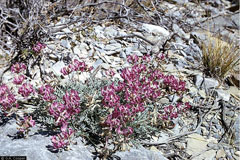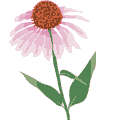 |
|
Clarence A. Rechenthin @ USDA-NRCS PLANTS Database |
 |
| G.A. Cooper @ USDA-NRCS PLANTS Database |
Translate this page:
Summary
Physical Characteristics

 Astragalus crassicarpus is a PERENNIAL growing to 0.5 m (1ft 8in) at a medium rate.
Astragalus crassicarpus is a PERENNIAL growing to 0.5 m (1ft 8in) at a medium rate.
See above for USDA hardiness. It is hardy to UK zone 7. The species is hermaphrodite (has both male and female organs) and is pollinated by Bees, Lepidoptera (Moths & Butterflies). The plant is self-fertile.
It can fix Nitrogen.
It is noted for attracting wildlife.
Suitable for: light (sandy) and medium (loamy) soils and prefers well-drained soil. Suitable pH: mildly acid, neutral and basic (mildly alkaline) soils. It cannot grow in the shade. It prefers dry soil.
UK Hardiness Map
US Hardiness Map
Synonyms
A. caryocarpus. Ker-Gawl. A. mexicanus. A. succulentus. Geoprumnon succulentum.
Plant Habitats
Cultivated Beds;
Edible Uses
Edible Parts: Seedpod
Edible Uses:
The thick fleshy unripe seedpods, which resemble green plums, are eaten raw or cooked[2, 177, 183]. They are highly esteemed[85]. The pods are about 25mm in diameter[235].
References More on Edible Uses
Medicinal Uses
Plants For A Future can not take any responsibility for any adverse effects from the use of plants. Always seek advice from a professional before using a plant medicinally.
Antispasmodic Haemostatic Stimulant
A compound decoction or infusion of the root has been used to treat fits and convulsions and has been used on bleeding wounds[257]. It has also been taken or used externally as a stimulant[257].
References More on Medicinal Uses
The Bookshop: Edible Plant Books
Our Latest books on Perennial Plants For Food Forests and Permaculture Gardens in paperback or digital formats.

Edible Tropical Plants
Food Forest Plants for Hotter Conditions: 250+ Plants For Tropical Food Forests & Permaculture Gardens.
More

Edible Temperate Plants
Plants for Your Food Forest: 500 Plants for Temperate Food Forests & Permaculture Gardens.
More

More Books
PFAF have eight books available in paperback and digital formats. Browse the shop for more information.
Shop Now
Other Uses
Nitrogen Fixer. Milk Vetch is often used as a cover crop and for erosion control. It improves soil fertility through nitrogen fixation and can be used in mixed plantings to enhance biodiversity.
Provides shelter for beneficial invertebrates: insects and other arthropods. A general nectary plant [1-2]. 1. Nectary - Flowers rich in nectar and pollen:
Yes – Milk Vetch species produce flowers that are rich in nectar, making them attractive to pollinators such as bees and butterflies.
2. Wildlife - Food (Fruit, Seeds, Leaf litter, Shelter, Nesting, Roosting):
Yes – The seeds of Milk Vetch are edible and can serve as food for various wildlife. The plant’s foliage may also provide cover for small animals, although it is not typically used for nesting.
3. Invertebrate Shelter (Overwintering sites, Leaf litter, Groundcover):
Yes – Milk Vetch can provide a habitat for invertebrates, and its leaves contribute to leaf litter that supports beneficial insects. Some species may spread out enough to offer ground cover.
4. Pest Confuser (Smell):
No – Milk Vetch is not specifically recognized for its ability to confuse pests through its scent.
Special Uses
Food Forest Nitrogen Fixer
References More on Other Uses
Cultivation details
Requires a dry well-drained soil in a sunny position[1]. Plants are intolerant of root disturbance and are best planted in their final positions whilst still small[200]. The stems are sometimes prostrate[200]. This species is somewhat polymorphic and is separated into a number of distinct species by some botanists[235]. The form sometimes known as A. mexicanus has larger seedpods than the type, up to 35mm in diameter[235]. This species has a symbiotic relationship with certain soil bacteria, these bacteria form nodules on the roots and fix atmospheric nitrogen. Some of this nitrogen is utilized by the growing plant but some can also be used by other plants growing nearby[200]. Many members of this genus can be difficult to grow, this may be due partly to a lack of their specific bacterial associations in the soil[200]. For polyculture design as well as the above-ground architecture (form - tree, shrub etc. and size shown above) information on the habit and root pattern is also useful and given here if available. The plant growth habit is a clumper with limited spread [1-2]. The root pattern is rhizomatous with underground stems sending roots and shoots along their length [1-2]. The leaves and young shoots can be harvested in spring and early summer. The seeds are typically harvested in late summer to early autumn. Milk Vetch usually flowers from late spring to mid-summer.
References Carbon Farming Information and Carbon Sequestration Information
Temperature Converter
Type a value in the Celsius field to convert the value to Fahrenheit:
Fahrenheit:
The PFAF Bookshop
Plants For A Future have a number of books available in paperback and digital form. Book titles include Edible Plants, Edible Perennials, Edible Trees,Edible Shrubs, Woodland Gardening, and Temperate Food Forest Plants. Our new book is Food Forest Plants For Hotter Conditions (Tropical and Sub-Tropical).
Shop Now
Plant Propagation
Seed - best sown as soon as it is ripe in a cold frame[200]. A period of cold stratification may help stored seed to germinate[200]. Stored seed, and perhaps also fresh seed, should be pre-soaked for 24 hours in hot water before sowing - but make sure that you do not cook the seed[134, 200]. Any seed that does not swell should be carefully pricked with a needle, taking care not to damage the embryo, and re-soaked for a further 24 hours[134, 200]. Germination can be slow and erratic but is usually within 4 - 9 weeks or more at 13°c if the seed is treated or sown fresh[134]. As soon as it is large enough to handle, prick the seedlings out into individual pots and grow them on in the greenhouse for their first winter, planting them out into their permanent positions in late spring or early summer, after the last expected frosts.
Other Names
If available other names are mentioned here
Ground plum, Buffalo bean, Groundplum milk-vetch, Buffalo pea [1-4].
Native Range
NORTHERN AMERICA: Canada, Saskatchewan, Alberta, Manitoba, British Columbia (southeast), United States, Illinois, Iowa, Kansas, Minnesota, Missouri, Nebraska, North Dakota, Oklahoma, South Dakota, Wisconsin, Colorado, Montana, Wyoming, Arkansas, New Mexico, Texas, Arizona, Mexico, Coahuila de Zaragoza,
Weed Potential
Right plant wrong place. We are currently updating this section.
Please note that a plant may be invasive in one area but may not in your area so it's worth checking.
Conservation Status
IUCN Red List of Threatened Plants Status :

Growth: S = slow M = medium F = fast. Soil: L = light (sandy) M = medium H = heavy (clay). pH: A = acid N = neutral B = basic (alkaline). Shade: F = full shade S = semi-shade N = no shade. Moisture: D = dry M = Moist We = wet Wa = water.
Now available:
Food Forest Plants for Mediterranean Conditions
350+ Perennial Plants For Mediterranean and Drier Food Forests and Permaculture Gardens.
[Paperback and eBook]
This is the third in Plants For A Future's series of plant guides for food forests tailored to
specific climate zones. Following volumes on temperate and tropical ecosystems, this book focuses
on species suited to Mediterranean conditions—regions with hot, dry summers and cool, wet winters,
often facing the added challenge of climate change.
Read More
Expert comment
Author
Nutt.
Botanical References
60200
Links / References
For a list of references used on this page please go here
Readers comment
© 2010, Plants For A Future. Plants For A Future is a charitable company limited by guarantee, registered in England and Wales. Charity No. 1057719, Company No. 3204567.